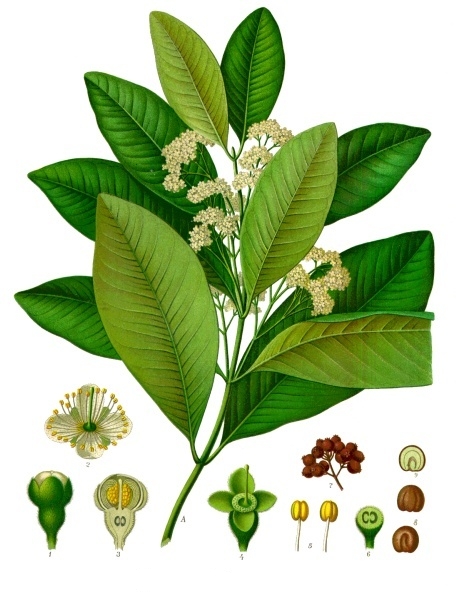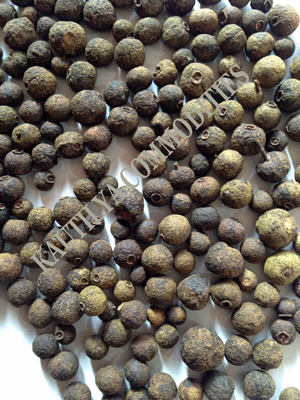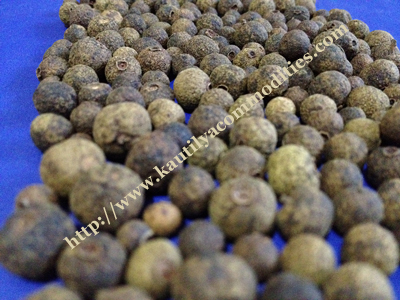
Interesting Facts...
 Humans were using spices
in 50,000 BC. The spice trade developed
throughout the Middle East in around 2000 BC with
cinnamon
and pepper, and in East Asia (Korea, China) with
herbs and
pepper.
Humans were using spices
in 50,000 BC. The spice trade developed
throughout the Middle East in around 2000 BC with
cinnamon
and pepper, and in East Asia (Korea, China) with
herbs and
pepper.
 In the 18th century, Holland had such a fiercely
guarded monopoly on the
clove
trade that the government made growing or selling
cloves
outside its colony of Amboina, in Indonesia, a crime
punishable by death. The Chinese were said to use
them as far back as 226 BC. Apparently they chewed
the flowerettes prior to having an audience with the
Emperor so that their breath would not smell bad.
In the 18th century, Holland had such a fiercely
guarded monopoly on the
clove
trade that the government made growing or selling
cloves
outside its colony of Amboina, in Indonesia, a crime
punishable by death. The Chinese were said to use
them as far back as 226 BC. Apparently they chewed
the flowerettes prior to having an audience with the
Emperor so that their breath would not smell bad.
 Cardamom is used to break up kidney stones and gallstones,
and was reportedly used as an antidote for both snake and
scorpion venom. Guatemala is the largest producer of cardamom
in the world with an average yield of between 25 thousand
to 29 thousand metric tons annually.
Cardamom is used to break up kidney stones and gallstones,
and was reportedly used as an antidote for both snake and
scorpion venom. Guatemala is the largest producer of cardamom
in the world with an average yield of between 25 thousand
to 29 thousand metric tons annually.
 Vanilla
is the only edible fruit of the orchid family,
the largest family of flowering plants in the world
Vanilla
is the only edible fruit of the orchid family,
the largest family of flowering plants in the world
 The early term for "merchant" in Austronesian is *dagang
(Dempwolff) and this word is very similar to one of
the terms for "ocean."
The early term for "merchant" in Austronesian is *dagang
(Dempwolff) and this word is very similar to one of
the terms for "ocean."
 Columbus' far-fetched proposal to reach the East
Indies by sailing westward received the support of
the Spanish crown, which saw in it a promise,
however remote, of gaining the upper hand over rival
powers in the contest for the lucrative spice trade
with Asia
Columbus' far-fetched proposal to reach the East
Indies by sailing westward received the support of
the Spanish crown, which saw in it a promise,
however remote, of gaining the upper hand over rival
powers in the contest for the lucrative spice trade
with Asia
 The Cashew Nut is actually a seed and not a "nut",
in the botanical sense. The seed is surrounded
by a double shell containing an allergenic phenolic
resin, anacardic acid, a potent skin irritant
chemically related to the more well known allergenic
oil urushiol which is also a toxin found in the
related poison ivy. Properly roasting cashews
destroys the toxin, but it must be done outdoors as
the smoke (not unlike that from burning poison ivy)
contains urushiol droplets which can cause severe,
sometimes life-threatening, reactions by irritating
the lungs.
The Cashew Nut is actually a seed and not a "nut",
in the botanical sense. The seed is surrounded
by a double shell containing an allergenic phenolic
resin, anacardic acid, a potent skin irritant
chemically related to the more well known allergenic
oil urushiol which is also a toxin found in the
related poison ivy. Properly roasting cashews
destroys the toxin, but it must be done outdoors as
the smoke (not unlike that from burning poison ivy)
contains urushiol droplets which can cause severe,
sometimes life-threatening, reactions by irritating
the lungs.
 While native to Brazil, the
Portuguese took the
cashew
plant to Goa, India, between the years of 1560
and 1565. From there it spread throughout Southeast
Asia and eventually Africa.
While native to Brazil, the
Portuguese took the
cashew
plant to Goa, India, between the years of 1560
and 1565. From there it spread throughout Southeast
Asia and eventually Africa.


 |


Allspice
Description
Allspice is the dried fruit of the Pimenta dioica
plant. The fruit are picked when green and unripe
and, traditionally, dried in the sun. When dry, the
fruit are brown and resemble large brown
peppercorns. The whole fruit have a longer shelf
life than the powdered product and produce a more
aromatic product when freshly ground before use.
Allspice was encountered by Christopher Columbus on
the island of Jamaica during his second voyage to
the New World. Having never seen pepper, mistook
Allspice for pepper, took it back to Spain where it
was called pimiento (meaning pepper) and its
Anglicized name “pimento” is still used in the spice
world, It was introduced into European and
Mediterranean cuisines in the 16th century.
Kautilya Commodities is a supplier of Allspice
from Guatemala

The Allspice Tree
(Source:
http://pharm1.pharmazie.uni-greifswald.de/allgemei/koehler/koeh-eng.htm)
Growth
The allspice tree,
classified as an evergreen shrub, reaches heights
between 10 and 18 m(32 and 60 ft). Allspice can be a
small, scrubby tree, quite similar to the bay laurel
in size and form. It can also be a tall, canopy
tree, sometimes grown to provide shade for coffee
trees planted underneath it. It can be grown
outdoors in the tropics and subtropics with normal
garden soil and watering. Smaller plants can be
killed by frost, although larger plants are more
tolerant. It adapts well to container culture and
can be kept as a houseplant or in a greenhouse. The
plant is dioecious, meaning plants are either male
or female, hence male and female plants must be kept
in proximity to allow fruit to develop.
Many attempts at growing the pimenta from seeds were
reported, but all failed. Experiments were then
performed using the constituents of bird droppings;
however, these were also totally unsuccessful.
Eventually, passage through the avian gut, either
the acidity or the elevated temperature, was found
to be essential for germinating the seeds

Allspice from Guatemala, pimienta
gorda

Allspice
from Guatemala is one of the best in the world
For further
information about availability, quality, price and
specifications of Allspice, please
contact us.
Home
|
















